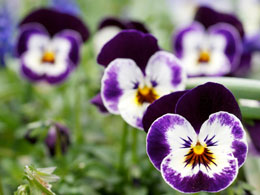Pansy flowers are delicate, bright, and strikingly beautiful, and they make a wonderful addition to any garden. Read on to know more about their uses and the best way to grow and take care of these lovely plants.
 Flowers are the sweetest things God ever made and forgot to put a soul into
Flowers are the sweetest things God ever made and forgot to put a soul into. - Henry Ward Beecher
Pansies are one of the earliest spring blossoming plants. In warm regions, pansies flower in late winter and spring, whereas in cool regions, they flower in summer. They are biennials, but mostly planted as annuals. The name originally came from the French word
pensie, which means, 'thought' or 'remembrance'. According to floriography (the practice of assigning symbolic meanings to flowers), 'pansy' stands for 'loving thoughts'. They have a wide range of bright and brilliant colors. They also have light fragrance. They have three basic petal color patterns - first is a single uniform color pattern, second is a single color pattern with a black line radiating from the center (the black line is called penciling) and the third pattern is with a dark center. Some people describe the dark inner region, as 'faces'. Among the three patterns, the pansies with faces, are most commonly grown. They are mostly cultivated as garden flowers.
Growing Pansies
Besides the dazzling colors, the popularity of pansies is partly due to the fact that they are easy to grow. They are regarded as a 'plant for all seasons'. Pansies grow well in full sun or semi-shade, but can tolerate cool weather. They grow 6-10 inches high and spread up to 10-12 inches wide. Some of the tips for growing these plants are as follows:
- Pansies propagate by means of seeds. It is better to sow seeds in early season, so that the flower will bloom in time. After sowing seeds, cover the bed lightly with soil, so as to enhance seed germination.
- Thorough watering should be done once after sowing. Germination time varies according to the weather condition, but normally they germinate slowly.
- When the seedlings reach to a certain height, transplant them into your garden or in pots according to your wish. After transplantation, care should be taken in order to protect the young plants from frost.
- Planting should be done with a gap of about 6 inches in between each plant. However, they will stand a little crowding.
- In order to create a good color contrast pattern, you can always choose mixed varieties. Flowering time differs according to the variety. Some species flower as early as nine weeks after sowing and some may flower within the first year.
Uses of Pansies
Many of the florists are not aware about the edibility of pansies. Usually, they plant pansies for their garden value. People use pansies in flower arrangements, as wedding flowers and some of the silk varieties are used as bridal flowers. But the fact is that, in addition to these, these plants can be used for a variety of other purposes. Let's take a look at some of the uses.
- Both the leaves and flowers are edible and have a mild, minty taste. They are a rich source of vitamin A and C.
- Mostly, the leaves and flowers are used as garnishes in cakes, fruit salads, green salads, desserts and soups. Many people freeze the petals in ice cube trays and use in drinks.
- Pansies are used to make syrup, honey, and salad because of its strong flavor.
- They are used to prepare a wide range of dyes.
- It has been found out that the plants can be used for herbal medicinal purposes.
Taking Care of Pansies
Pansies seldom have problems with diseases and pests. However, it is always better to buy healthy and resistant varieties. Diseases to watch out for include leaf spot, stem rot and mildew. Pests like aphids, snails, and slugs can attack the plant. One of the causes of diseases may be due to nutrient imbalance. If any of the diseases occur, the following steps can be taken.
- If there are diseases such as leaf spot, stem rot, or mildew, treat the plants with fungicide. You can also use a mild organic or chemical insecticide. For pests, use mild pest repellent. Also, remove and destroy the fallen, diseased leaves regularly.
- Water the plants regularly. Watering should be sufficient and uniform, otherwise it will attract diseases.
- It is recommended to water the soil deeply; watering should not be done in the plant leaves but should be done entirely in the soil.
- Try to avoid using chemical fertilizers, instead you can apply organic compost for better aeration and moisture conservation.
Pansies are such a wonderful flower, with several values. So, the next time, when you decide to make a change to your garden, do think of planting pansy flowers. You will really enjoy the view.






 Flowers are the sweetest things God ever made and forgot to put a soul into. - Henry Ward Beecher
Flowers are the sweetest things God ever made and forgot to put a soul into. - Henry Ward Beecher